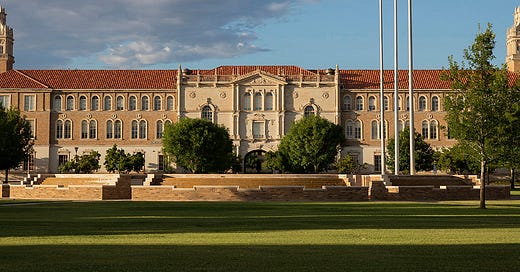2022 Pricing: Texas Tech
CTAS cost forecasts for Texas Tech's 22/23 academic year and full 4-year program
CTAS is sharing its projections for 2022/23 academic year costs with information on individual colleges as a recurring feature. Similar information for over 3,000 2- and 4-year schools is available at the CTAS site.
This post projects average net costs for Texas Tech University in Lubbock.
Admitting roughly 70% of applicants with a student body size of ~29,000 students (full-time-equivalent basis), Texas Tech primarily educates state residents but welcomes ~300 out-of-state students each year into a campus, or about 6% of its total entering class. The school boasts very solid retention with ~85% of first years returning for a second year. Students with higher test scores receive discounts, but at a lower level than the University of South Carolina. Texas Tech increases merit aid by approximately $2k for each 100 point improvement in the SAT (1600-pt scale), a schedule which appears to apply to both in- and out-of-staters. The school is not open about its discounting, but seems to do it selectively. About half of students receiving some form of institutional aid with a special effort to provide for lower-income students.
These projections represent informational projections that will change over time and are not a commitment either by CTAS or the applicable colleges. Figures are rounded to the $500 avoid false specificity. Final net cost numbers will differ from these estimates for many reasons: changes to economic trends, decisions by the colleges both about their own policy and enrollment, as well as decisions about individual students. Estimates of full program costs assume graduation in 4-years (for Bachelor’s) or 2-years (Associate) without any gaps, delays or added semesters/quarters. We take pride in our numbers so, if you believe any should be corrected, please reach out to us at support@collegetuitionadvisoryservices.com and we will work with you to resolve the issue.
Average Net Cost is a consumer-centric metric which shows costs as they are presented in commercial transactions outside of higher education. It represents a full-time student’s cost of attending college including: tuition, room & board, fees and estimates of supplies less institutional aid of all kinds (including need-based and merit), and less federal and state/local aid. Loans and other repayable amounts, along with work study earnings, are excluded and do not reduce the cost. Room and board charges are on-campus costs for residential colleges; for students attending non-residential institutions, the college's own estimate of such off-campus costs is mostly used. CTAS' Net Cost differs from the Net Price figure self-reported by colleges because it is comprehensive and covers all entering students, including the approximately 40% not included in Net Price calculations.
Please find more information at the CTAS site. Reports for residents of a given state and for individual colleges are available for different membership tiers.





